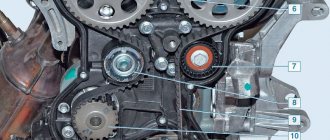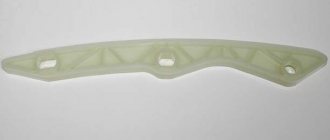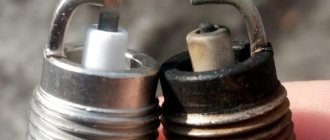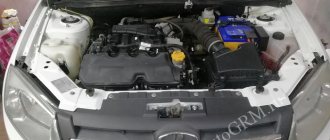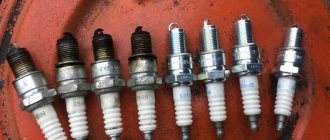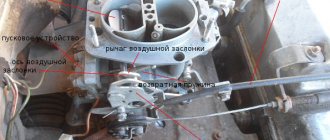Which candles are better?
The “life” of nickel or conventional spark-forming elements in domestic conditions is shortened for reasons beyond our control. It is enough to refuel with low-grade gasoline once, and replacing the spark plugs on the Mitsubishi Lancer 9 is guaranteed. Question: are more expensive iridium varieties, which are even recommended by the manufacturer (although for some reason only for 2-liter modifications of the Lancer 9), capable of withstanding low-quality fuel? After all, their declared resource is twice as large.
Often, one additive is added to Russian fuel, which kills any spark plugs. It increases the octane number. It contains a substance that leaves a harmful residue on the electrodes and causes a short circuit. Brick-colored deposits are visible to the naked eye.
The additive kills SZ (brick-colored deposits)
So what should we do? If the additive kills all spark plugs, what's the point of buying expensive iridium ones? For this reason, many people use conventional products at a low price. If problems arise with sparking, they replace them with new ones. Drivers of another category (there are fewer of them) buy expensive spark plugs, hoping for their high quality. In most cases, they do not fail; they wear out only after a decent mileage. It turns out that both options have their pros and cons.
The best manufacturers
The most famous on the market are Denso, Bosch, Champion and NGK. The latter is known for being the first to receive permission to produce iridium spark plugs.
There is no point in relying on any one company. They all do their job equally well and do not have any special advantages in their class. Technical indicators are decisive.
It is obvious that the best candles in the world are mercilessly counterfeited. And here the car owner must be on guard. Models should be purchased only at large and well-known outlets, taking into account the cost of the original products. For example, if you know that the original SZ from Denso costs 300 rubles, then the option for 100 rubles should immediately arouse suspicion.
Replacing spark plugs
Mitsubishi Lancer X / Engine
Replacing spark plugs on a Mitsubishi Lancer X is a very simple task that will take a few minutes of free time. The manufacturer recommends replacing iridium spark plugs every 90,000 kilometers, at least that’s what is written in the Mitsubishi service manuals. In fact, the Rolf service center recommends changing them every 60,000 kilometers, most likely this is due to the poor quality of gasoline in Russia.
To replace spark plugs you must:
- An extended 16 socket or a 16 spark plug wrench with a lock; it is advisable that the outer diameter of the wrench be as small as possible, otherwise it will not fit into the spark plug wells.
- Torx E10 socket for 1.5 liter engine. For 1.8 and 2.0 engines, a regular 10mm hex socket is used.
- Spark plugs - 4 pcs.
Spark plugs for Mitsubishi Lancer X 1.5i:
- Mitsubishi MN176628 - original spark plug
- Bosch 0 242 235 769 — spark plug
Spark plugs for Mitsubishi Lancer X 1.8i and 2.0i:
- Mitsubishi MN163236 - original spark plug
- Mitsubishi MN163807 - original spark plug
- NGK FR6EI - spark plug
- Denso K20PSR-B8 - spark plug
Please note that when purchasing original Mitsubishi spark plugs, the box will contain spark plugs from Bosch (for a 1.5-liter engine), and NGK or Denso (for 1.8 and 2.0-liter engines). The fact is that Mitsubishi in this case is only a packer, and the above companies are engaged in the production of candles
Knowing this, for the same amount you can buy two sets of candles instead of one.
Let's start replacing the spark plugs on the Mitsubishi Lancer X
1. First of all, you need to open the hood and remove the top plastic engine cover by pulling it up.
2. If there is a large amount of dust and debris on the engine, it is advisable to blow everything thoroughly. After this, you can begin to unscrew the ignition coil mounting bolts using a 10mm or Torx E10 socket, depending on the type of bolts.
3. Now you need to disconnect the low-voltage input plug of the ignition coil, then pull the coil up and put it aside.
4. Immediately below the coil there will be a spark plug, which must be unscrewed using a spark plug wrench with a magnetic or plastic lock. If you are using a regular extended socket, the spark plug can be pulled out using the fuel hose:
5. Screw the new spark plug into place. If you have a torque wrench, it is advisable to tighten the spark plug to a torque of 25-30 Nm
6. Reinstall the parts in the reverse order of removal.
When to change and what spark plugs to put on Lancer 9
Of course, you will also need spark plugs. The number of the original spark plugs is MS851358. Among analogues, it is recommended to take NGK BKR6E-11 or Denso K20PR-U11.
On the 9th generation Lancer, the manufacturer gives the frequency of replacing spark plugs at 30 thousand km. (if these are ordinary spark plugs) and 60 thousand km (iridium).
The necessary keys to unscrew the coils and unscrew the spark plugs.
Disconnect the coil power plugs on both sides.
They can be removed without difficulty (press a little from above and pull).
Now take the key to “10” and unscrew the four bolts of the coils.
After which we will proceed to removing the ends of the explosive wires and the coils themselves.
We remove the high-voltage wire of the first spark plug...
We do the same with the third candle well.
Then you can start removing the coils
After you have pulled out the coils and spark plug tips, you can start replacing the spark plugs on your ninth Lancer.
Using a spark plug wrench, unscrew the spark plug of cylinder 1. If the unscrewed spark plug does not hold in the key, to remove it from the well, use the removed spark plug tip. Do the same procedure with all the remaining candles and collect everything in reverse order.
The best manufacturers
The most famous on the market are Denso, Bosch, Champion and NGK. The latter is known for being the first to receive permission to produce iridium spark plugs.
There is no point in relying on any one company. They all do their job equally well and do not have any special advantages in their class. Technical indicators are decisive.
It is obvious that the best candles in the world are mercilessly counterfeited. And here the car owner must be on guard. Models should be purchased only at large and well-known outlets, taking into account the cost of the original products. For example, if you know that the original SZ from Denso costs 300 rubles, then the option for 100 rubles should immediately arouse suspicion.
List of internal combustion engine modifications
Initially, the management of the Mitsubishi concern took into account aspects of the legislation of the countries to which engines or cars with them were exported, therefore, with a base engine power of 127 hp. With. this characteristic was artificially lowered - by firmware of the on-board computer, using different attachments for the intake/exhaust tract.
Such modernization allows us to distinguish three conventional modifications of the 4G18 motor:
- 98 l. With. – ICE for Europe and the Russian Federation, meets Euro-5 regulations, allows you to reduce insurance payments and road tax;
- 105 l. With. – the motor was supplied to the Middle East;
- 122 l. With. – Iran received the most powerful engine.
Flywheel 4G18
The 4G18 engine does not have any turbo versions or naturally aspirated options with design changes.
What spark plugs besides the recommended ones can be installed on a Mitsubishi Lancer? | Topic author: Veronica
Anastasia You didn’t specify the engine, this is for 1.5. CompanyArticleInfo. DescriptionCash. Min. order, pcs Expected time, days Price Requested item Bosch0 242 235 769 Spark plug 971 RUR 1,324.80 Analogs Oleg for the requested article DensoIKH20Spark plug, “Iridium Power” RUB 1,15,419.52. DensoIKH20 Spark plug, “Iridium Power” RUR 1,422.64 DensoIKH20 Spark plug, “Iridium Power” 12901 RUR 2,447.03 DensoIKH20#4 Spark plug, “Iridium Power” 44 RUB 3,466.72 MitsubishiMN 176628 Spark plug RUB 1,12,617.39 MitsubishiMN 176628 Spark plug RUR 1,10,619.58 MitsubishiMN 176628 Spark plug 41 RUR 2,752.75 DensoI44 Spark plugs, “Iridium Power”, set 4 5 2 381.42 RUR.
Replacing the timing belt Mitsubishi Lancer 9 1.6. Photos, instructions on how to change the timing belt on Lancer 9
Timely replacement of the Mitsubishi Lancer timing belt is very important, since a break bends the valve. Therefore, there is no need to delay, especially since you can change the timing belt of a Lancer 9 with a 1.6 engine yourself.
When to change and which timing belt is best for Lancer 9
The frequency of replacing the Mitsubishi Lancer 9 timing belt is 90,000 km.
In addition, the belt must be changed if cracks and delaminations, abrasions and other signs of tooth wear, protruding threads, and also traces of oil on the surface of the belt are found.
Oil destroys rubber and can get onto the belt due to leaky seals (crankshaft or camshaft).
Often, along with the timing belt, the tensioner pulley is also replaced.
Often, when choosing which timing belt is better, the original is called the original. However, if you are not satisfied with their price, you can make a certain compromise with quality and take an analogue.
Catalog numbers of the timing belt Mitsubishi Lancer 9 (engine 1.6 4G18):
Catalog numbers of tensioner roller Mitsubishi Lancer 9:
Replacing a timing belt at a service station will cost about 2,500 rubles for the work itself - the procedure takes about 2 and a half standard hours, and the cost of a standard hour is determined around 1,000 rubles.
How to change the timing belt Lancer 9
Step-by-step instructions for replacing the timing belt are presented in the photo above. The main points of the procedure are described in more detail here.
Tools you will need: ratchet with heads 10, 12, 19, wrench 12, pliers, jack with stops, screwdriver, marker, wrench.
- You can change the timing belt not only on a pit or a lift. There is an option to get by by jacking up the front part (with the installation of stops, of course) and removing the right wheel.
- Removing the crankshaft pulley can be difficult - unscrewing the fastening bolt is sometimes not easy.
The most effective way is to unscrew it with the starter. To do this, you need to turn off the ignition coils (you can also power the injectors, just in case), install the head on the bolt and adjust the knob to it so that it rests on the lever or the ground. Then, in short attempts (no more than 1 second), crank the starter - the bolt should come off the first time. You can try to unscrew the bolt in another way, if you have a partner who will press the brake pedal with fifth gear engaged. The repair manual contains advice on unscrewing the crankshaft pulley bolt using an old alternator belt. Many people speak negatively about this option. - Lancer 9 timing marks (crankshaft and camshaft) are set after the crankshaft pulley, pump, and lower casing have already been removed. To set the marks, you need to switch to 5th gear, install the wheel and turn it until the marks of the camshaft and the engine block coincide. Then check the crankshaft mark; when the marks on the camshaft and the engine block converge, it should also match.
- When installing the tension roller, the spring is not installed immediately. After screwing the roller, you need to put on the timing belt so that the side opposite the roller is tightened. After this, a spring is installed, due to which the belt is automatically tensioned. Then the central bolt of the roller is screwed on.
Tightening torque of threaded fasteners when replacing the timing belt (for 4G18/13 engines):
- crankshaft pulley mounting bolt - 128 Nm;
- pump pulley mounting bolt - 9 Nm;
- pump mounting bolt - 13 Nm;
- belt tensioner mounting bolt - 23 Nm.
Advantages and disadvantages
The simple design of the internal combustion engine makes maintenance and repair easier; the attachments are arranged quite well and have a long service life. The engine can be operated on AI-92 gasoline. The main disadvantages of the power drive are:
- bending of valves when the belt drive breaks;
- unfinished cooling system (increased lubricant consumption after 100,000 km);
- hydraulic compensators are found on cars for the Russian Federation in approximately 50 cases out of 100, so it may be necessary to adjust the thermal valve clearances after driving every 30,000 km.
Pump 4G18
During repairs, instead of the original pistons, modifications with counterbore are often installed, after which the engine does not bend the valve when the timing belt breaks. The pump has a metal impeller, so it lasts for 90,000 miles, which allows you to change the pump at the same time as the timing belt.
The secret to quality ignition: stay informed!
If the spark plug is unstable, the engine will not work to its full potential: it will be difficult to start the car when cold, and the power and stability of the engine will also decrease. A faulty spark plug is a headache for any driver: do not neglect the procedure for replacing components, otherwise problems with the operation of the car will occur.
The only factor affecting the quality of spark plug ignition is the gap between the electrodes of the device. By changing the gap size, the ignition speed is adjusted: a larger distance increases the ignition zone and time, a smaller distance increases the speed. The best option is to set the gap between the electrodes according to the car’s technical book, however, this rule applies only at the beginning or middle of the engine’s operational life, when approaching a major overhaul - the ignition will have to be set literally blindly, taking into account the characteristics of the engine.
List of car models in which it was installed
Initially, the 4G18 engine was used in four Mitsubishi cars:
- Kuda - SUV for Indonesia;
- Colt Plus – Taiwan market only,
- Space Star – a hatchback with a body increased by 30 cm;
- Lancer is a compact sedan.
However, the engine characteristics are fully suitable for third-party cars:
- BYD F3 – Chinese version of Lancer;
- Zotye nOMAD – power 78 hp. pp., 2007 – 2009, Chinese SUV;
- Proton Waja - Malaysian sedan;
- Hafei Saima – compact Chinese hatchback;
- Foton Midi - from 2010 to 2011, Chinese A-class compact van.
Zotye nOMAD
The Russian C-class sedan Tagaz Aquila was also equipped with this 107 hp engine. With.
Mitsubishi Lancer 9
The new Mitsubishi Lancer 9 model was officially introduced in Russia in 2003 and was equipped with 1.3 liter, 1.6 liter and 2.0 liter petrol engines.
Mitsubishi Lancer (IX) 2000-09
The front suspension of Lancer 9 is McPherson type, the rear suspension is multi-link. The same suspension was used on the first Mitsubishi Outlander (Airtrek).
The Mitsubishi Lancer 9 model was produced for almost ten years, most recently under the name Mitsubishi Lancer Classic. Buyers liked the solid and practical interior, calm and modern body design, and fairly quiet suspension.
- The specialists of the Orbita service station will carry out all types of plumbing work efficiently and quickly.
- We provide a guarantee on all work and our spare parts for Lancer 9.
- Lancer 9 service is carried out at the Orbita service station quickly and efficiently.
- Above you can select the service you are interested in, find out its cost and the current price list for spare parts.
Servicing a Mitsubishi Lancer 9 does not require large financial costs. This model does not have any “diseases” and all the spare parts that have to be changed from time to time on this car are so-called “consumables”.
Our specialists will quickly select all the spare parts for Lancer 9 necessary for repair.
Almost all spare parts that are required to carry out the above work are constantly maintained in stock at our service station (brake discs and pads, timing belt, Mitsubishi filters and oils, antifreeze, brake fluid and other technical fluids, clutch, wheel bearing, shock absorbers). All spare parts are original and high-quality analogues.
Repair of Mitsubishi Lancer 9 can be divided into scheduled maintenance and routine repairs.
Scheduled maintenance means:
- Mitsubishi oil change
- Replacing filters (oil, air and cabin filters)
- Replacing brake fluid
- Changing automatic transmission and manual transmission oil
- Replacing the fuel filter (in the tank)
- Mitsubishi timing belt replacement
Mitsubishi Lancer 9 is one of the most popular cars in Russia in its segment.
Choosing spark plugs for Mitsubishi Lancer 9 with 1.6 engine
Mitsubishi initially equipped the 1.6 liter 4G18 engine with conventional nickel-coated spark plugs NGK MS851358 and DENSO MS851728, which are of the “cold spark plug” type and have a high heat rating.
According to the maintenance regulations, it is proposed to replace it every 30 thousand mileage when using high-quality gasoline.
In real Russian conditions, it is not always possible to refuel a car with fuel of the appropriate quality. The use of various additives to increase the octane number of gasoline significantly reduces the service life of conventional spark plugs.
Design Features
Within the series, the 4G18 engine was the penultimate modification with the largest combustion chambers, the volume of which is 1.6 liters. design features are:
- 4 cylinders are made of liners inside a cast iron block, arranged in a row;
- the cast iron exhaust manifold has a narrowed diameter to comply with Euro 4/5 standards;
- the gas distribution mechanism has a SOHC V16 design, that is, one overhead camshaft with 12 cams controls 16 valves through rocker arms mounted on two axles;
- the COP system regulates the ignition angle using a vacuum valve mounted on the throttle valve;
- The camshaft drive is belt driven, its resource is limited to 100,000 km maximum;
- the cylinder head is aluminum, narrow due to the single-shaft timing mechanism;
- one wide cam controls the two exhaust valves of each cylinder, two narrow cams open the intake valves;
- the user can carry out major repairs and boosts with his own hands.
Cylinder block Camshaft 4G18 COP system Scheme SOHC V12
Engines have hydraulic compensators, but not all of them, so the operating budget is increased either by using high-quality oil or by periodically adjusting the thermal valve clearances, which the manufacturer recommends every 30,000 km.
Replacing spark plugs on a Mitsubishi Lancer 9: the devil is not as scary as they make him out to be!
The replacement procedure does not require specialized skills or a lot of free time - all you need for the job is a set of spanners, a 16-point spark plug wrench, and a sheet of sandpaper. To replace spark plugs on Lancer 9 you must:
- Open and place the hood on the locking stop, then turn off the power supply circuit of the car by disconnecting the negative terminal from the battery;
- Next, you need to remove the blocks with low-voltage ignition coil connectors on both sides of the engine cover;
- Then we unscrew the fixing bolts from the ignition cover and pull the tip of the high-voltage cable towards us from the fourth well of the cylinder head. Upon completion of the procedure, we carry out similar operations with 2 and 3 wells;
- Putting the cable aside, unscrew the old spark plug from the first well with a spark plug wrench and pull out the device using the rubber tip;
- Then we install a new spark plug in the first well and carry out an identical operation with the remaining cylinders. After installing the components, we lay the high-voltage cable and connect the ignition coil. Next, we connect the blocks with harnesses to the coil and add a negative voltage to the battery.
Upon completion of the repair, a control test is performed to ensure functionality. When choosing non-original components, the spark plugs may be filled with an air-fuel mixture: in this case, the parts are not compatible with the car and require calibration - by adjusting the fuel supply, you can set the spark plugs for optimal performance.
- www.drive2.ru
- www.drive2.ru
- lancer-faq.ru
- zapchasti.expert
Replacement
If you do not know how to replace spark plugs on a Mitsubishi Lancer 9, then we provide instructions to help.
- Remove the pads from the low-voltage inputs of the ignition modules (marked with green arrows).
- Unscrew the coil mounting bolts.
- Remove the tip of the armored wire from the first well in the cylinder head cover.
- Remove modules from all wells.
- Unscrew the first spark plug; it is located inside the well.
To make it easier to turn out, the key should have a plastic or magnetic lock. Then all that remains is to remove all the other SZs and insert new ones in their place.
Choose your candles wisely for your lancer. Remember that expensive does not mean the best, and cheap does not always mean the worst. Try to choose elements with a large number of electrodes, soldered with precious metals. Give preference to products from well-known companies.
Replacing spark plugs
Replacing spark plugs on a Mitsubishi Lancer X is a very simple task that will take a few minutes of free time. The manufacturer recommends replacing iridium spark plugs every 90,000 kilometers, at least that’s what is written in the Mitsubishi service manuals. In fact, the Rolf service center recommends changing them every 60,000 kilometers, most likely this is due to the poor quality of gasoline in Russia.
To replace spark plugs you must:
- An extended 16 socket or a 16 spark plug wrench with a lock; it is advisable that the outer diameter of the wrench be as small as possible, otherwise it will not fit into the spark plug wells.
- Torx E10 socket for 1.5 liter engine. For 1.8 and 2.0 engines, a regular 10mm hex socket is used.
- Spark plugs - 4 pcs.
Replacing the ignition coil Mitsubishi Lancer 9
The ignition coils on the Mitsubishi Lancer 9 last quite a long time, provided that the spark plugs are replaced in a timely manner. Unlike other cars, where each cylinder has its own coil, Lancer 9 has only 2 coils for 4 cylinders. In addition to the coils themselves, tips can fail, as well as spark plug wires, which over time can begin to “punch through”.
Signs of faulty ignition coils
The exact malfunction can only be determined using computer diagnostics, which will indicate faulty parts, but by the characteristic signs you can determine for yourself what is broken.
For example, when driving smoothly, after sharply pressing the gas pedal, the car begins to twitch and what is called “stupid” without developing power. In some cases, the Check light on the dashboard may light up. These signs indicate that there may be a problem with the ignition coil, wires or tips.
The engine may stall or run unstably at idle; this may also be one of the reasons for the malfunction of the ignition coils.
Which coil to choose for replacement
The original Mitsubishi MD362903 (MD361710) coil was installed from the factory. Its price at the moment is more than 5,000 rubles per piece. You can, of course, purchase it and replace it, or you can choose a cheaper analogue.
- Delphi GN10450-12B1 from 1900 RUR
- Denso DIC01-07 from 3900 RUR
- ERA 880.190 from 1500 RUR
- Masuma MIC300 from 1700 rub.
- NGK 48 225 from 3200 RUR
All the above coils are analogues of the original one. However, before purchasing coils, we advise you to check with the seller again whether the coil is suitable for your motor.
When replacing the coil, we also advise you to pay attention to the tips and spark plug wires. It is better to change them together with the coil
- Mitsubishi MD342893 - high-voltage spark plug wire from 900 rubles. thing.
- Mitsubishi MD365102 - high-voltage wire spark plug set 2 pieces from 1600 RUR
- Mitsubishi MD342894 - spark plug wire price from 900 rubles per piece.
After dismantling the old coil and wires, we recommend checking them with a multimeter. In general, the ideal option is to dismantle the old coil and wires, check them, and only then, after identifying faulty components, purchase and replace them. Of course, if you want to change everything completely, then checking is not necessary.
How to check ignition coils and wires
The picture below contains detailed instructions for checking the coils and wires. All you need is a working multimeter and some free time.
Instructions for replacing the Lancer 9 ignition coil yourself
So, we disconnect the wire blocks from the two coils. The blocks are gray; to disconnect them from the coil, you need to press the latch and pull the block towards you.
Next, using a 10 mm wrench, unscrew 2 bolts securing the coils to the body.
Carefully pull out the tips with wires from the wells. Now you can either change everything completely, or check the coils and wires with a multimeter.
Before dismantling the coils and wires, we advise you to remember their location.
We perform assembly in reverse order. New wires may be noticeably tighter on the spark plugs - this is normal. Also, often the new wires are a few mm wide. longer than the original ones. There's nothing wrong with that.
Analogs
Old candles. Insulators are broken. The engine will stall and run poorly.
- Bosch 0 242 232 502
- Brisk 0035
- Champion EON1/286
- Champion EON1/287
- Denso K20TT
- Eyquem 0911007193
- Hella 8EH 188 704-011
- Master-sport U-SERIE-MS-14
- NGK 1496
- Vemo V99-75-1020
- Valeo 246871
DENSO SPARK PLUG - the simplest inexpensive candles. According to reviews, they last a long time and work well. The price is about 500 rubles for everything.
Which ones are better
The life of nickel or conventional spark-forming elements in domestic conditions is shortened for reasons beyond our control. It is enough to refuel with “left” gasoline once, and replacing the spark plugs on the Mitsubishi Lancer 9 is guaranteed. Question: are more expensive iridium types of electrodes, which are even recommended by the manufacturer (although for some reason only for 2-liter modifications of the Lancer 9), capable of withstanding low-quality gasoline? After all, their declared resource is twice as large.
Often one additive is added to our Russian fuel, which kills any SZ. We are talking about an additive that increases the octane number of fuel. It contains a substance that tends to leave a harmful residue on the electrodes, causing a short circuit. Sediment can be seen on the spark-producing element. These are brick-colored deposits.
So what should we do? If the additive kills all spark plugs, what's the point of buying expensive iridium ones? Indeed, most Russian drivers buy cheap models and don’t worry about the choice. If problems arise with sparking, they replace them with new ones.
Drivers of another category (there are fewer of them) buy expensive options, hoping for their high quality. And in most cases they do not fail, requiring replacement only after a decent mileage. It turns out that both options have their pros and cons.
Maintenance schedule 4G18 1.6 l/98 – 122 l. With.
The naturally aspirated Japanese 4G18 engine, made in China, will last more than 300 thousand km if you adhere to the maintenance regulations:
- It is recommended to change the oil and the corresponding filter every 10 thousand in the absence of hydraulic compensators or 5 thousand if they are present;
- The timing belt resource is 90,000 miles, it is usually changed at the same time as the pump;
- attachment belts are serviced more often - after 30,000 miles;
- purging of crankcase ventilation is required at the turn of 20 thousand km;
- a cast iron exhaust manifold can burn out only after 100,000 miles;
- The service life of candles is 2 years on average, the battery is 5 years, but a lot here depends on the design and manufacturer;
- The fuel filter must be replaced after 40,000 km, and the air filter after 15 - 20 thousand mileage;
- depending on operating conditions, antifreeze loses its properties after a run of 40–50 thousand km.
An exhaust manifold
All operations can be performed independently in the garage and even in the field.
Replacing spark plugs on Lancer 9 1 6 with your own hands
The process of replacing spark plugs on a Lancer is not a difficult task, but it can put a damper on ownership. All you have to do is break the thread, and there will be problems. Despite this, even an inexperienced car enthusiast can do all the work. The main thing is to follow the recommendations presented below.
What is needed for replacement
You will need a long 16mm spark plug wrench with a magnet.
Replacing spark plugs is carried out with two keys:
- Socket wrench 10. Used to unscrew the ignition coil.
- Spark plug for 16. Needed for removing and installing spark plugs.
Experts advise buying a spark plug wrench with a plastic or magnetic retainer. The ideal solution would be a spark plug from a 16-valve VAZ.
Many motorists are faced with a problem when the spark plug key simply does not fit into the well. To prevent this from happening, you need to choose a candlestick with a smaller outer diameter (about 22 mm less than required). If the key does not fit into the spark plug well, you can lubricate it with a small layer of oil.
The photo shows that the walls of the spark plug keys vary in thickness.
Algorithm
We find two low-voltage inputs of the ignition coils. They have connectors installed that need to be removed. This is done without any tools or excessive effort - lightly press from above and pull to the side. Remove 2 terminals of the ignition coils. Use a 10mm wrench to unscrew the coil mounts. There are 2 bolts on each coil. Using a 10mm head, unscrew the 4 bolts securing the coils. Now we remove the high-voltage wire from the first spark plug well. At its end there is an ignition coil. Remove the ignition coils one by one. Similarly, remove the tip from the fourth well
This must be done as carefully as possible, since during removal the spring installed between the spark plugs and the coil may jump out. It's very easy to lose her
We return the spring to its place. The same actions should be done with the remaining two wells. Set aside the high-voltage wires with coils - no manipulations are expected with them. After dismantling the coils with wires, free access to the spark plugs opens. Now we take the spark plug wrench and unscrew the spark plug from the first well. To avoid problems when removing it, you must use a key with a magnetic or plastic lock. If it is not there, then you can do the following: first unscrew the spark plug, and then take it out of the well using a rubber tip. In this case you need to act very carefully. When removing the candles, we look at their condition. Oil leaks on the spark plug body indicate a worn spark plug well sealing ring. We insert the new spark plug into the spark plug wrench, after which it needs to be installed in place of the old one. Twist it well. There is a metal ring at the end of the spark plug, do not lose it when installing. Similar actions should be done with the remaining cylinders. After this, you need to replace the ignition coils. We fix the coils with bolts, after which we need to connect the connectors.
Periodicity
The timing of replacement depends on what kind of spark plugs you use in your car.
The manufacturer recommends replacement at the following intervals:
- Conventional spark plugs are changed every two years or after the car has covered 30,000 km.
- Spark plugs with iridium or platinum coated electrodes last twice as long, that is, 4 years or 60,000 km.
conclusions
When replacing spark plugs, you may accidentally touch the hose on the valve cover - do not forget to put it back on the fitting.
The spark plug replacement is complete. You can now perform a test drive. To perform this procedure, you do not need to contact a service center at all - you can perform all the steps yourself.
conclusions
When replacing spark plugs, you may accidentally touch the hose on the valve cover - do not forget to put it back on the fitting.
The spark plug replacement is complete. You can now perform a test drive. To perform this procedure, you do not need to contact a service center at all - you can perform all the steps yourself.
Sources
- https://etlib.ru/report/643-zamena-svechej-lanser-9
- https://carfrance.ru/menyaem-svechi-na-mitsubisi-lanser-9-s-dvigatelem-1-6-litra/
- https://info-mitsubishi.ru/aksessuary/svechi-na-mitsubisi-lanser-9.html
- https://zapchasti.expert/mitsubishi/lancer-9/svechi-lancer-9.html
- https://carfrance.ru/svechi-zazhiganiya-na-mitsubishi-lancer-9-1-6/
- https://servicing-auto.ru/zamena-svechej-na-mitsubishi-lancer-ix/
- https://lancer-faq.ru/car/mitsubishi-lancer-ix-1-6i/zamena-svechej-zazhiganiya-ix-1-6.html
[collapse]
About the types of spark-producing elements
Without a good spark, the operation of a car with a gasoline engine is unthinkable. The task of the SZ is simple - to convert the current received from the battery into a spark. The latter must be of such strength that it is capable of igniting the mixture.
Spark plugs for Mitsubishi Lancer 10 and 9 are consumable material. They are subject to mandatory updating after a certain time. According to the manufacturer's recommendations, after 30-60 thousand kilometers. The specific resource depends on the model of the spark-forming element - iridium ones last longer (4 years).
Classification by electrode type
Models are classified according to different parameters. One of them involves a difference in the electrode.
- Classic spark plugs consist of a main and an additional electrode.
A spark jumps between them and ignites the gasoline. Such elements may have grooves of different shapes, increasing the size of the torch. There are also models with a protruding electrode; they can improve ignition, but are only suitable for certain power units. Two-electrode spark plug 1 - central electrode; 2 - side electrode; 3 - V-shaped groove; 4 - U-shaped groove; 5 - difference in the amount of electrode protrusion. - Multi-electrode spark plugs are made using an improved design.
Such elements may have several side electrodes, but only one central one. Multi-electrode varieties produce a more stable spark, improve engine performance and increase service life. Multielectrode SZ - Torch candles are not equipped with additional electrodes.
Sparking occurs using a spherical resonator, measured and non-stop. They are considered the best options today, but given their cost, they are not very popular. Flare SZ
How to extend the life of spark plugs
- Choose original spark plugs whose characteristics match the car engine.
- Beware of fakes, do not buy too cheap spare parts, check the part numbers and packaging.
- Carry out independent replacement only if you have experience in such work and know the intricacies of the process.
- Keep track of replacement intervals.
- Pay attention to any engine malfunctions and contact a car service center at the first sign.
- Use high-quality fuel, change consumables on time.
The service life of spark plugs is reduced when the vehicle is operated over short distances, when the engine does not have time to warm up sufficiently. To prevent carbon deposits from accumulating too quickly, it is recommended to periodically drive at moderately high speeds.
Which candles are better?
The “life” of nickel or conventional spark-forming elements in domestic conditions is shortened for reasons beyond our control. It is enough to refuel with low-grade gasoline once, and replacing the spark plugs on the Mitsubishi Lancer 9 is guaranteed. Question: are more expensive iridium varieties, which are even recommended by the manufacturer (although for some reason only for 2-liter modifications of the Lancer 9), capable of withstanding low-quality fuel? After all, their declared resource is twice as large.
Often, one additive is added to Russian fuel, which kills any spark plugs. It increases the octane number. It contains a substance that leaves a harmful residue on the electrodes and causes a short circuit. Brick-colored deposits are visible to the naked eye.
The additive kills SZ (brick-colored deposits)
So what should we do? If the additive kills all spark plugs, what's the point of buying expensive iridium ones? For this reason, many people use conventional products at a low price. If problems arise with sparking, they replace them with new ones. Drivers of another category (there are fewer of them) buy expensive spark plugs, hoping for their high quality. In most cases, they do not fail; they wear out only after a decent mileage. It turns out that both options have their pros and cons.
Mitsubishi Lancer. DPRV
Tired of checking. The eyes blurred. I did other inspections and came back again and started checking again.
Extra impulses occur precisely during engine interruptions. I called an electronics engineer I know and told him about the problem. He suggested: “Maybe there’s some kind of crap on the computer?” No, guess what, they came out for oscillation. Sent. He looked and called back: “It’s strange... some very clear impulses.” What happened to the car? — We went through the mechanics, wiring, burned a little… — Maybe somewhere the wires that go to the coil are pinched, or something is being shunted there… we need to look for parasitic signal sources. I rip apart all the wiring from the “brains” to the ignition coil. The work is still the same... I cut all the wiring: when the previous masters were repairing, they shorted the “plus” to power the coils - this wire burned out and fused other wires around it. I look carefully. I replace all the wires with new ones. I check everything with a megometer - everything is normal. So the motor should be working correctly? I start it, accelerate it - the same thing again. I broke my whole head. Where does this parasitic impulse come from? This is nonsense, it shouldn’t exist, but it’s been verified. Well, for such a “difficulty” there is Dmitry Yuryevich’s golden phone (nickname mek, https://forum.mek1.ru/). He told me the problem. And immediately questions: - What did you do with the car? Told. — What changed on the car? Told. — What sensors were changed? “Yes, they changed, the previous masters changed a lot there: the camshaft and knee sensors, and the mass air flow sensor, and the rest, I can’t remember everything... “Come to me,” said Dmitry Yuryevich. We arrived with a client, I just had a day off. Dmitry Yuryevich asks without further ado: “Have you changed the camshaft sensor?” - They changed it. Dmitry Yuryevich turns to the assistant: - Look what’s there... Seconds later, from under the hood you can hear: - Chinese! Without unnecessary movements, Dmitry Yuryevich approaches the box, takes out something in cellophane, unpacks it and gives it to the assistant: “Put this one in.” We installed a sensor. Next, Dmitry Yuryevich commands: - Start it up! We started the engine. We started accelerating. A miracle happened: at all speeds the engine worked stably and without jerking. And at that moment I was terribly offended! To the core! I, such a one, spent so much time, effort and nerves, and Dmitry Yuryevich solved the problem within three minutes! Emotions are through the roof. I was simply shocked. We took an oscillogram:

